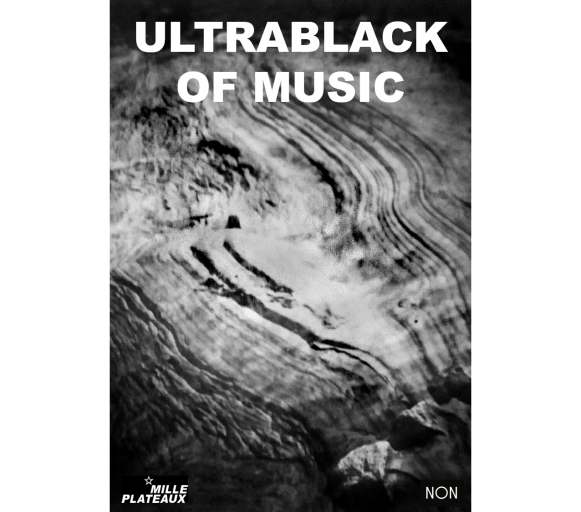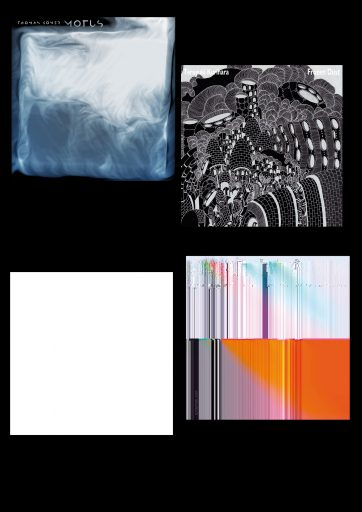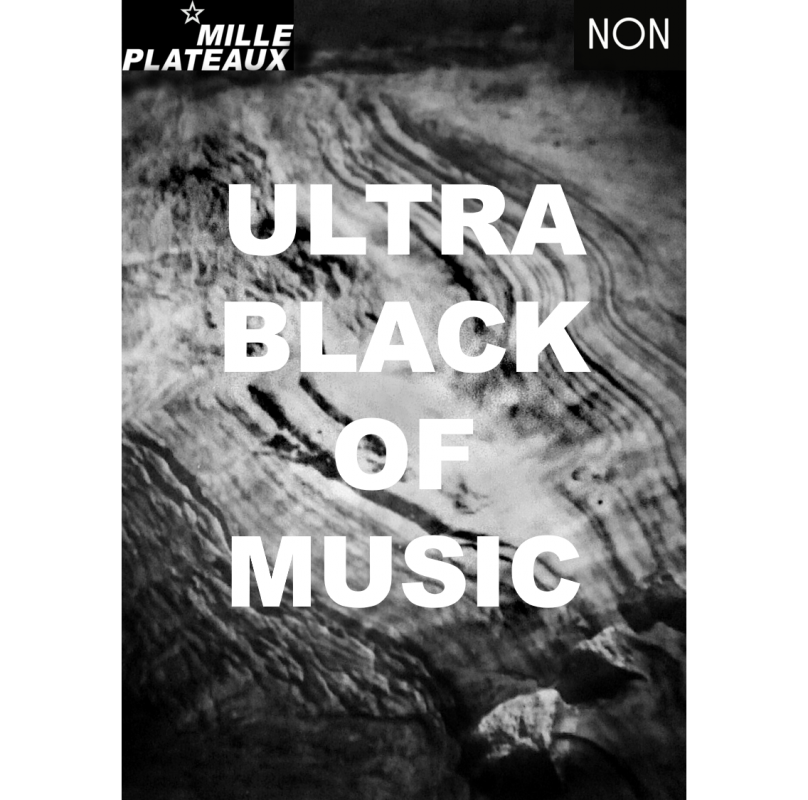you can order book here
book and Compilation you can order here
- Foreword – Dark Precursions. Technocultures, Inhuman Rhythmights and the Ultra-Black of Non-Music
Jan Heintz
“Thunderbolts explode between different intensities, but they are preceded by an invisible, imperceptible dark precursor, which determines their path in advance but in reverse, as though intagliated. Likewise, every system contains its dark precursor which ensures the communication of peripheral series. As we shall see, given the variety among systems, this role is fulfilled by quite diverse determinations. The question is to know in any given case how the precursor fulfils this role.” – Deleuze Difference and Repetition
The Force was always-there. When Mille Plateaux says, »when we look back it seems that MP was always dark. We never confirmed techno-utopism, accelerationism or Eshun’s afrofuturism.«, it sounds like a dark precursive dream working itself through, confronting intelligibility, without fully showing itself, subtracted from plain recognizability.1
A haunting rhythm – vibrating, pulsing, humming under the route of immanence, cutting through the concrete, when you listen close enough. The endeavour of Non-Music weaponized itself some time ago2 with the thought-synthesizing inventiveness3 and toolkit experimentality, so wildly performed by Deleuze and Guattari as a new generic mode of thinking and its ten thousand millions lines of flight, billion de/terretorialising wish-vectors – a conceptual bestiary sicced on the (geo)political, economic, aesthetic, cosmological and social problematics of their time. In a sense, D&G inaugurated a thought not cut off but deeply pierced, chaosmotically informed by the real, operating in, against, through, amidst it and becoming-other thereby.
On the other side: Non-Music experiences also how the ‘beautiful souls’ or pigs4 of our contemporary age, in their philistine ambitions, lace up one’s neck when they joyously whisper: we are different, but not opposed5… The celebration of difference, the search of immanence (the production of difference) bastardized into the cult of the new, myriad of lifestyles, ways of life and individuations locked up into narcisstic fever dreams whirling around in frenetic standstill.6
Toxic imaginative refluxes of Capital’s tendency to plunge everything into its horrible music of a harmonies-of-harmonies-in-the-last-instance: »The monstrous flesh of capital is the horizon, or the matrix, or the underlying location and container of our experience, as producers and consumers.«7 Society trapped in the chronosick cage of eternal capitalist malaise – accompagnied by the woke, numbing sound/procedures (standardized, well-calculated, dosed) of today’s automated, globalized techno-cultures and its proxies (club culture, sound production mechanisms etc.), stuck in a state of endless retro-necrophilia. Time is consequently whitened out, the world turned black.8
Against this backdrop Ultra-Black of Music speculates on the manifold ways in which the objective, inhuman soundworlds, which roar underneath humans’ sensological apparatus, pervade and smoothly colonize our humanoid-alien, affective and cognitive capacities – and how to construct ways out of the mess of the Master Rhythms of Sonic Thanaticist Capital and its stratagems of annihilation and pulpification.
Ultra-Black of Music is therefore also radical fictioning in a Laruellian sense: it is non-standard practice that encompasses artifact, performativity and construction, but in a non-expressive, non-representational and ultrablack sense.9 Speculative rhythm productions drive the mathematical ope-rationality and its decisional self-amputations to the edge and create the missing corporeality that rewires our affective capacities and inhibitions by un-mooring, alienating/de-realizing our relations to the killing abstractions (reductive Binarism, identitism/autism), the techgnostical mindset and its mystifications.10
Non-Frequency-Politics gears up for the Counter-Count.
Through all this, can there be a different relationality effactuated (sonically, theoretically, cosmotechnically) which alter the ways in which ‘we’ relate to that which ultimately lies outside of ‘our’ horizon? Does one not en-counter in the immense, uncontrollable sonic geologies/ecologies of Ultra-black a sonic vision of cosmos as radical alienness? Does one not hear in the gravity of Ultrablackness the immeasurableness of the real?
The strange nonhuman sonic fluxes listened to in Field Recordings touch the mimicry of Chaos,11 they »tell in an audible way about forces that are not audible. They make the music of the earth audible, which by its nature is raw, strange, intense.« This confronts and pushes us also into the experimentation with this nameless in-between, in which new temporalities can emerge whose winding paths and outcomes can neither be predicted nor guaranteed.
Ultra-blackness’ love is vigorously informed and fueled by the hate in ending this World, as we know, and sonically experience it.12
You never know in advance when Ultra-blackness strikes you like exploding thunderbolts.
1It is a blackness (in slight modification), »which no eye sees.«, s. Deleuze/Parnet (2009): L’Abécédaire (Letter Z).
2On the deep affinities between Deleuze and Mille Plateaux write Shores and Yalçın in their contribution. See also: Szepanski, Achim/ Reynolds, Simon/ Diefenbach, Katja (2017): Technodeleuze and Mille Plateaux. Achim Szepanski’s Interviews (1994-1996).
3»[Philosophy] is like a thought synthesizer functioning to make thought travel, make it mobile, make it a force of the Cosmos (in the same way as one makes sound travel).«, s. Deleuze, Gilles/ Guattari, Félix (2004): A Thousand Plateaus: Capitalism and Schizophrenia (translated by Brian Massumi). London/New York, p. 379.
4s. Châtelet, Gilles (2014): To Thinks and Live like Pigs. The Incitement of Envy and Boredom in Market Democracies. Falmouth.
5s. Deleuze, Gilles (1994): Difference and Repetition (transl. by Paul Patton). New York, p. xx.
6s. Berger, Edmund (2020): Frenetic Standstill. https://reciprocalcontradiction.home.blog/2020/01/10/frenetic-standstill/
7s. Shaviro, Steven (2008): The Body of Capital. http://www.shaviro.com/Blog/?p=641
8s. Mbembe, Achille (2017):Critique of Black Reason. Durham.
9s. p. 58.
10s. Pasquinelli, Matteo (Ed.) (2015): Alley of your Mind. Augmented Intelligence and its Traumas. Lüneburg.
11Szepanski writes in his NON-Essay Deleuze/Guattari und der Schizo-Attraktor: »Where music would no longer even [need to] be organized sound, but the diagrammatic constitution of a counterfactual space-time, which in addition enables a transformation of hearing within the possibilities offered by such a sound-music.«, s. Szepanski, Achim (2018): Deleuze/Guattari und der Schizo-Attraktor. https://non.copyriot.com/deleuze-guattari-und-der-schizo-attraktor-ultrablack-of-music-1/
12Galloway/Andrew Culp (2016): Ending the World as We Know It: Alexander R. Galloway in Conversation with Andrew Culp, https://www.boundary2.org/2016/06/ending-the-world-as-we-know-it-an-interview-with-andrew-culp/

Foreword – Dark Precursions.
Technocultures, Inhuman Rhythmights and the Ultrablack of Non-Music 7
JAN HEINTZ
Frédéric Neyrat Spectral Composition: on Spectral Music, Drone Metal, and Electronic Music
Achim Szepanski Ultrablack of Music
Holger Schulze Sonic Thanaticism. A Sensology of The Sonic Capital
Algorithmic Committee The Scream and the Sound of the Flesh
Marcus Schmickler & Julia Rohrhuber Politics of Frequency
Stefan Paulus Deterritorializations – Field Recordings, Recipes, Smooth Spaces and Body-without-Organs
Benjamin Noys Dead Detroit Lies Dreaming: Techno (Anti-) Accelerationism
Shintaro Miyazaki Don`t Forget to Change The Beat from Time to Time – About Counter-Raving
Thomas Brinkmann Nullen & Einsen
Bernd Herzogenrath in|human rhythms
Jose Rosales Bergsonian Science-Fiction: Deleuze, Eshun, and Thinking the Reality of Time
Zafer Aracagök Two Fragments about Rhythm and Nano-Fascism
Corry Shores/Meli̇ke Başak Yalçın From Rhythm to Glitch: Digital Deformation in Deleuze
Taylor Adkins/ Joseph Weissman Melody and Morphogenesis
Alessio Kolioulis Techno is the message / Reflections on the short circuits of the electronic music industry
Thomas Köner Ten Thousand Millions
Txgen Meyer Connega(c)tive approaches to the production of vibrational matters
Gerriet Sharma Surrounded by Immersion – Means of Post-Democratic Warfare
Bill B. Wintermute (Cybernetic-)‘Post-Pop‘: affect art(s) & (emotional) self-governing
Book (including Compilation with 35 Artists/tracks) on NON/Mille Plateaux Release Date 2/2020
Alessio Kolioulis
Techno brings people together (and pushes them apart) – Is it still relevant to talk about techno music as an autonomous form of emancipatory politics? Techno collective Scan 7’s famous slogan ‘techno brings people together’ speaks of an era that has ceased to exist. With the end of rave culture, the electronic music scene demonstrates the opposite. The only way to re-connect with each other is perhaps a disconnection from social media.
Gerriet Sharma
The most successful advertising today convincingly takes on the qualities of real experience. These experiences may be concerts, multi-media events, games and VR-applications. Rose asks: From 3D to VR, the goal is to eliminate any barrier between person and experience. What if we could have an unmediated experience?
Frédéric Neyrat
In this essay, I don’t aim at analyzing a specific genre of music: my goal is rather to grasp a musical configuration encompassing musicians as different as Gérard Grisey, Sunn O ))), Thomas Köner, Chloé, Emptyset, or Bérangère Maximin. Paying attention to the spectral technique of composition, drone metal, and electronic music, the musical configuration I attempt to define obviously doesn’t consider the full extent of contemporary music, but sheds some light on a Grundstimmung – a basic mood, a fundamental tone that, I argue, is at stake in crucial contemporary musical works.
Achim Szepanski
When non-frequency-politics listens to the clock, it does not hear the uniform tictic, tic, but it hears tic – toc – fuck the clock. Non-frequency-politics works with the Click, which is now to be understood as an inherent stress that falls on certainmetrics or beats, whereby each further beat is put under stress and this repetitive stress is the Click-Clock in the Sound – different possibilities of overlaying and concatenating Clicks, Pulses and Noises up to groupings of Beats, which in turn are distributed into unequal patterns.
Zafer Aracagök
The nonconceptual in fact is the residue of Neanderthal capitalism, because whatever it appropriates in the name of a monadology (which doesn’t even know what a window is) is prone to get lost within the atopology of the surface as the unmaintable. The nonconceptual therefore is not the opposite of the conceptual, but that which is always already yet to come. Imagine, for example, Ian Curtis sang his songs always from within a coffin and when he committed suicide he was already dead. The double negative at work here is not there to affirm the death-affirming voice of the Despot, but to negate radically what is being imposed on us as conceptual and affirmative.
Thomas Köner
The vast world Sound is blackened through and through. All sound objects in this world are becoming more and more dark: ten thousand million electronic sounds called “Preset 01”; ten thousand million concrète sounds called “rec 01”; ten thousand million rhythmic sounds called “groove 01”; ten thousand million acoustic sounds called “instrument 01”; ten thousand million deep drones; ten thousand million looped rhythms; ten thousand million granular syntheses; ten thousand million desertions of the dance floors; ten thousand million from the DJ’s first “endarkenment”; ten thousand million beats per minute; ten thousand million wavetables; ten thousand million vector syntheses; ten thousand million consummated ecstasies; ten thousand million crossfades; ten thousand million MIDI channels; ten thousand million software updates; ten thousand million shared mp3 files; ten thousand million needle pulses; ten thousand million envelope speeds; ten thousand million frequency bands; ten thousand million self-oscillations; ten thousand million pure sine wave tones; ten thousand million vibration amplitudes, ten thousand million silences.
Benjamin Noys
Detroit techno is now a musical form over thirty-years old, further away from today than 50s rock-and-roll was from my youth. Detroit Techno has been left behind. There is an ironic effect of obsolescence, which is ironic as the futures sketched by Detroit techno never arrived. They remain as encoded ‘alien’ messages from a future that did not take place. The Red Planet, a record label from early 90s Detroit, was here once on earth. Now the red planet is the site of NASA fantasies of alien ‘life’ or ‘planet B’, as an unlikely escape route from a dying earth. As North America was to maritime exploration, so Mars is to ideologues of space settlement.vii There is no planet B.viii Kim Stanley Robinson’s Aurora is the novel of that. Already Detroit Techno could be understood as that message. There is also, however, no planet earth, for the brothers from another planet.ix Our planet is estranged.
Holger Schulz
Citizenship in the nation states of the early twenty-first century is
inextricably bound to the praxis of consumption. Only if you
consume in the requested, orderly, and obedient way, you can
perform your full rights as a citizen. If you deny, question, ridicule,
resignify or recontextualize the praxis of consumption and its
sensological, panacoustic and nanopolitical implications, you
might factually lose your citizen rights by policing actions directed
towards your everyday life and you political agency. The citizen is
therefore the main commodity and its consumer at the same time.
In this way, it is an immensely valuable and literally inexhaustable
asset to maximize sonic capital – and to expand it further, beyond
any sustainable limits, in the direction of its full annihilation. This
annihilation is its main goal, according to thanaticist capitalism: “a
social order which subordinates the production of use values to
the production of exchange value, to the point that the production
of exchange value threatens to extinguish the conditions of
existence of use value.” (McKenzie Wark)
Stefan Paulus
But maybe Eber, Lanz, Jupitter-Larsen and Dando just left the house with a little song in their minds that day, and left the course until they found themselves on stray lines with twists, knots and gestures, on oscillating lines and became. Perhaps this is also the reason for the disjunctive negentropy of »Wellenfeld«. What one imagines »does not lie in what one hears, what one hears, one searches in vain in the pictures« (Szepanski http://edition-mille-plateaux.de/elektronische-musik-deleuze-laruelle/). In this nameless in-between, the wave field is created.
Shintaro Miyazaki
Counter-Raving is a way to disentangle oneself from the unwanted, discriminating, unfair ways of technologies’ capture and which does not lure us into withdrawal, but into re-pair, re-entanglement and reformation. As an idea yet to be put into practice, counter-raving is inspired by many predecessors, projects and movements such as R3 Soundsystem, Acid Communism, Algo-Raving, Disobedient Electronics, etoy, Electronic Disturbance Theater, Critical Engineering1 and blended with the vibes of early Techno music as an emancipatory political movement. It is a group and community-oriented gesture, and builds strongly on dynamics of collective joy and its mobilization.
Thomas Brinkmann
From the holes as negative in the continuum of the paper, to the on/off-states of circuitries: Claude Shannon formalizes information in binary interplay and reduces it to the mathematics of communication. Exceeding or falling short of threshold values by means of sensation or their absence (literally saturation of the senses). Behind it are hidden desires for kicks and thrills, which are accompanied by permanent »disruption«, interruption or disturbance. The term »entropy« used by Shannon slips from the junk of character strings into ashes. Endproduct of entropy and a kind of event-horizon in whose »Schwarzschild«-radius of zero, matter disappears. Ultrablack of whatever. But perhaps also an Ultrawhite that offers an alternative to the fashionable black. In fact, one is created by the adaptive, physiological mixture of light and the other by its absence.
Bernd Herzogenrath
For Deleuze and Guattari, the »tyranny of meter« is related to it being a nonproductive (or only reproductive) and thus empty periodicity, a static repetition that does not produce difference, a difference they relate to becoming: »Meter, whether regular or not, assumes a coded form whose unit of measure may vary, but in a non-communicating milieu, whereas rhythm is the Unequal or the Incommensurable that is always undergoing transcoding. Meter is dogmatic, but rhythm is critical« (Deleuze and Guattari 1987: 313). Metric repetition is thus the repetition of the identical, creating equal units of time, whereas rhythm – real productive repetition, repetition with a difference – involves inequalities, maybe non-linear logics: intensities that create »incommensurabilities between metric equivalent periods or spaces« (Deleuze 1994: 21).
txgen Meyer
It must be taken into consideration that Earth is an assemblage; in isolation it is in a continuous becoming-toward-death. It is only through a becoming-toward-knowledge in which an entering into unheard expressive territories unveils a tuning-bridge to the plane of duality comprehension. It is necessary that any body in attempt to connect to this plan(e) practices precision-discipline. Planetary uncertainty of chaos on Earth is a result of the axiomatization of the body of the Planet by Majoritarian sound. »Man has failed: spiritually, educationally, governmentally; he has failed. Well then, he should be a good sport and say ›I give up, I need help‹.« In his exploration of the potential impossible of the unknown, the truths Ra expounds has been attested to by scientists, theorists, philosophers, and musicians since the beginning of human sound as the cosmic vibrations have stayed relatively constant.
Adkins/Weissman
Positing that philosophy may be dreamed otherwise, we conduct a non-standard philosophical experiment according to the musical model. Installing a plastic, collective, and abstract motor scheme into writing, we synthesize and investigate several occultural instances, including Adorno’s musical intervention in popular astrology, the uncanny loop of Proust’s ‘dream book,’ Simondon’s elaboration of crystalline amplification… Can this material be elaborated according to another (unilateral) syntax? Examining these instances, we offer an unacceptable hypothesis: the sentience of music.
In the time of the refrain, we discover sonocultures—cultivations of sound-worlds, crystallizations of temporal, spiritual and politico-economic lines. We suggest the concept of musiconomy as a vehicle for analyzing the extended criticality of life, thinking, and the city from an experimentally-unified musico-morphogenetic perspective. For musiconomy, time is the object of a design practice. In this sense, art and especially music capture or recover chronogenetic potentialities and thereby produce or dismantle crystals of time.
How do our knowledges of life, cities, and thinking individuate? We offer several musiconomic theses: urbanism, cognition, musicality (1) participate symmetrically in living structures of determination (extended crisis); (2) continuously transform via symmetry changes according to specific principles of individuation; (3) respond to temporizing morphogenetic principles (Longo/Montévil) or chaosmotic abstract machines (rediscovering Guattari with Deleuze). It is in the spironomic melt-up or transdifferentiation of living forms, societies, and ideas that we find or create ways to dream philosophy.
Algorithmic Comittee
In fact, a Model-Image of the Rhizome that excludes all other hypothetical copies, or other simulacrum-images, would take us straight back to the Platonic dialectic that we, and Deleuze in many of his texts, repeatedly refuted. Piano Piece for David Tudor 4, in the context of A Thousand Plateaus, can be conceived as a polyrhythmic element of composition, within a »conceptual and melodic landscape« that resonates and recalls both the Plane-Rhizome as an open system, and the whole text in form of a plateau as an asystematic stratification, as well as the initial »meter or cadence« of an iconic seriality that innervates every fiber of the book of »soundsense«.
Bill b. Wintermute
Culture Industry undergoes certain historical shifts, moving from Culture Industry/Spectacle to the mode of Pop (I, then II) and nowadays Post-Pop. While the »classic« culture industry thesis, as well as Debord‘s spectacle, assume a central-monopolist structure. Nowadays the spectrum has differentiated under the pressure of »subculture(s)«. In the time between
beginning of the 20th century (~1920) to the end of it (~1990) emergence of genres was successive.
more text to come
compilation tracks of ultrablack of music:
Thomas Köner – 10 000 000 000
Antonia – when fires burn
B Ashra – Gas
Bienoise – Infinitiny
Bill B. Wintermute – Calling all. This is our last cry before our eternal silence.
bpmf – Swing In The Sky
Zafer Aracagok / SIFIR – Desonance
DJ Durbin – Lash of Love
echonaut – hyroglyph
EPS – asymptotic 808
Richard Scott – EXP922
Gerriet K. Sharma – firniss redux
Jette – Thicket
Khem One – Copperopolis
Marcel Daemgen – Frohes Neues Jahr
Mijk van Dijk – Hoffnung Stirbt Zuletzt
Zoy Winterstein – Mira Mar
Solar Debris – Maevan Cellar
Dinis – alentejo ambient
Dr. W – Schatten der Erinnerung
Dr NoiseM – Monster
omsk / Dr. W – sofaacid reconx
Stine M – undermining
Svensyntetics – ambigue
NicoNote – Paysage mélodique avec Artaud
Obsolete Capitalism: Paesaggio_Melodico_V2496 MASTER DEFINITIVO VINILE
Pavel Zhagun – Memo
Schmickler Rohrhuber
Somnambule – Euphony Of The Machines
Stefan Paulus – Stratum
The Allegorist – Levitating Forms
Thomas Brinkmann – VIE/KGD
Automatisme – Alter – Rate 1
Listen to Gianluca Iadema Aphàiresis (Full Album) / Mille Plateaux
Releases on Mille Plateaux 1/2/3 2020
presales on Bandcamp here
MP4 Teruyuki Kurihara. Frozen Dust
MP5 Automatisme. Alter-
MP6 Thomas Köner. Motus
MP7 John-Robin Bold



